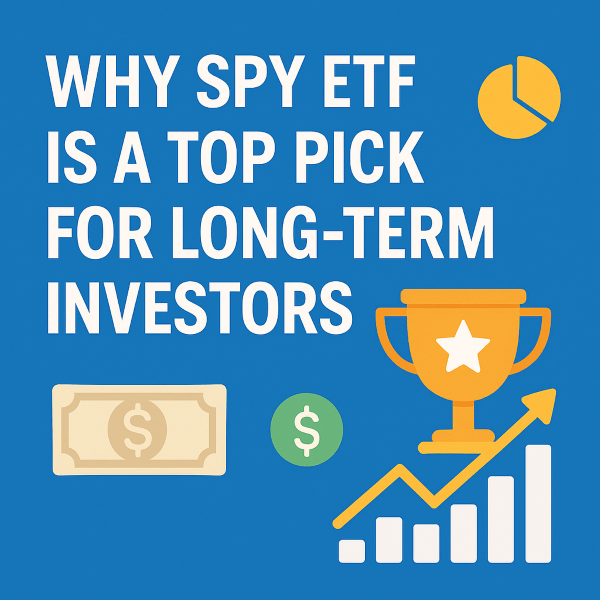Last Updated on May 30, 2025 7:14:56 PM by Vivek Makwana
Discover Why SPY ETF Is A Top Long-Term Investment Pick With Strong Returns, Low Fees, And Exposure To 500 Leading U.S. Companies.
📌 If You’re Looking To Build Wealth Steadily Over Time, The SPY ETF Could Be Your Ideal Long-Term Partner. Let’s Explore Why It’s A Favorite Among American Investors.
📘 What Is SPY ETF?
🔍 SPY ETF, Officially Called The SPDR S&P 500 ETF Trust, Is An Exchange-Traded Fund That Mirrors The S&P 500 Index — A Benchmark Made Up Of 500 Leading U.S. Companies Including Apple, Microsoft, Amazon, And Alphabet.
✅ Managed By State Street Global Advisors (SSGA), SPY Was Launched In 1993 And Is The Oldest And Most Traded ETF In The U.S. Market.
📈 Strong Historical Performance
📊 SPY Has Delivered Average Annual Returns Of About 10% Including Dividends, Making It A Solid Performer For Long-Term Investors.
💹 As Of May 2025, The SPY ETF Trades Around $591.15, Reflecting Decades Of Steady Growth Backed By The U.S. Economy’s Largest Companies.
💼 Broad Market Exposure
🧠 When You Invest In SPY, You’re Gaining Exposure To All 500 Stocks In The S&P 500 — From Tech Giants To Healthcare Leaders.
📂 Sector Allocation As Of 2025 Includes:
- 🖥️ Information Technology
- 💊 Health Care
- 🏦 Financials
- 🛒 Consumer Discretionary
📉 This Level Of Diversification Helps Spread Risk While Capturing Overall Market Growth.
💰 Reliable Dividend Payouts
💵 SPY Pays Quarterly Dividends, Making It A Source Of Passive Income On Top Of Price Appreciation.
📅 The Current Dividend Yield Is Around 1.23%, Based On Recent SSGA Reports. These Dividends Can Be Reinvested For Compounding Returns Or Taken As Cash.
🔁 High Liquidity And Accessibility
📈 SPY Is Among The Most Liquid ETFs In The World, With A Daily Trading Volume Often Exceeding $20 Billion.
🔄 This Means:
- ✅ Quick Entry And Exit
- 💸 Low Bid-Ask Spreads
- 🔁 No Holding Period Restrictions
🙌 Whether You’re An Active Trader Or A Passive Investor, SPY Fits Nearly Every Strategy.
💳 Low Expense Ratio
💰 SPY’s Expense Ratio Is Just 0.09%, Meaning For Every $10,000 You Invest, You Pay Only $9 Per Year In Management Fees.
🆚 That’s Significantly Lower Than Most Mutual Funds, Making It An Efficient Long-Term Holding.
🎯 Who Should Consider SPY?
💡 SPY Is Ideal For:
- 📊 Retirement Savers
- 💸 First-Time Investors
- 🏦 401(k) And IRA Holders
- 📈 Anyone Looking For Long-Term, Stable Growth
⚠️ Risks To Consider
While SPY Offers Many Benefits, Keep These In Mind:
- 📉 Market Risk – SPY Moves With The S&P 500, So Short-Term Volatility Is Inevitable.
- 🧾 Tax Implications – Dividends And Capital Gains Are Taxable Unless Held In A Tax-Advantaged Account.
- 🕰️ Not For Timing The Market – SPY Is Best Suited For A “Buy And Hold” Strategy.
📘 How To Invest In SPY From A U.S. Brokerage
➡️ It will cover:
- Steps To Open A U.S. Brokerage Account
- Recommended Platforms (e.g., Fidelity, Schwab, Vanguard)
- How To Buy SPY ETF (With Screenshots If Needed)
- Tax Considerations
- Dollar-Cost Averaging Strategy
- Tips For Beginners
🧠 Final Thoughts
🌟 SPY ETF Continues To Be A Trusted, Transparent, And Time-Tested Option For Long-Term Investors In The U.S.
🏛️ With Its Proven Track Record, Broad Diversification, And Low Costs, SPY Makes A Compelling Case For Anyone Looking To Grow Wealth Over The Years — Whether Through A Roth IRA, 401(k), Or A Standard Brokerage Account.
❓ Frequently Asked Questions (FAQs)
Q1. What Is SPY ETF?
🧠 SPY ETF, or SPDR S&P 500 ETF Trust, is an exchange-traded fund that tracks the S&P 500 Index, offering exposure to 500 of the largest publicly traded companies in the U.S.
Q2. Is SPY ETF A Good Investment For Beginners?
✅ Yes, SPY is considered beginner-friendly due to its diversification, low expense ratio, and long history of stable returns.
Q3. How Does SPY ETF Pay Dividends?
💵 SPY pays quarterly dividends based on the earnings of the underlying companies in the S&P 500. These dividends can be reinvested or taken as cash.
Q4. What Is The Expense Ratio Of SPY ETF?
💳 As of 2025, SPY has an expense ratio of 0.09%, meaning you pay just $9 annually for every $10,000 invested.
Q5. Can I Hold SPY In My Retirement Account (401(k)/IRA)?
🏦 Absolutely! SPY is commonly held in both 401(k) and IRA accounts due to its long-term growth potential and broad market exposure.
Q6. What Are The Risks Of Investing In SPY ETF?
⚠️ Risks include stock market volatility, economic downturns, and inflation. However, its diversification helps reduce company-specific risks.
Q7. What’s The Historical Performance Of SPY ETF?
📈 SPY has delivered average annual returns of about 10% since its inception in 1993, including dividends.
Q8. Is SPY Better Than Mutual Funds?
📊 SPY generally has lower fees and higher liquidity than mutual funds. However, the choice depends on your investment style and goals.
Q9. How Do I Buy SPY ETF From A U.S. Brokerage?
💼 You can buy SPY through any major U.S. brokerage like Fidelity, Vanguard, Schwab, or Robinhood by searching for the ticker symbol “SPY.”
Q10. Is SPY ETF Suitable For Long-Term Investing?
🌱 Yes, SPY is ideal for long-term investors seeking steady capital appreciation and exposure to the overall U.S. economy.
ETFs Vs Mutual Funds: What’s The Difference & Which Is Better?


